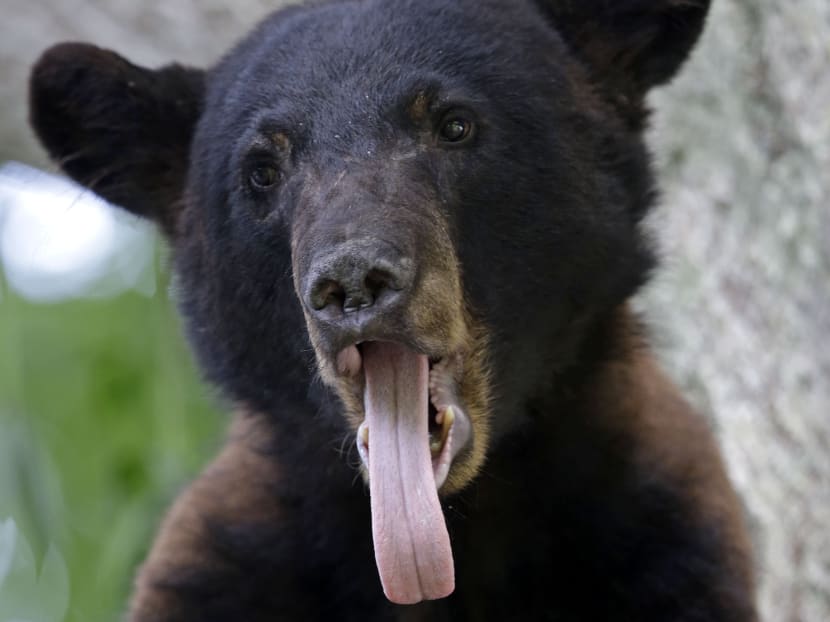Louisiana black bear could move off threatened-species list
BATON ROUGE (Louisiana) — Federal and Louisiana officials say it’s time to get the animal that inspired teddy bears off the list of protected species.

A Louisiana black bear, a protected sub-species of the black bear, is seen from its perch in a water oak tree in Marksville, Louisiana, Sunday, May 17, 2015. Photo: AP
BATON ROUGE (Louisiana) — Federal and Louisiana officials say it’s time to get the animal that inspired teddy bears off the list of protected species.
The Louisiana black bear population, once down to fewer than 100, has recovered, and the US Fish and Wildlife Service is making a formal proposal to remove the bear from the list of threatened species, Deputy Director Steve Guertin said yesterday (May 20).
State Wildlife and Fisheries Secretary Robert Barham said millions of children “can go to sleep cuddling their teddy bears and be sure that bear will be around for generations to come”.
The news conference was on the Governor’s Mansion lawn in front of tall banners, one with a photo of a little cub on a tree and the words “A Louisiana legacy ... recovered” and the other with a yearling bear and “Our state mammal ... the Louisiana black bear”.
Removal from the list would eventually let hunters kill at least a few of the bears that inspired plush “Teddy’s bears” after President Theodore Roosevelt refused to shoot a tied-up animal for a hunt trophy in 1902.
Any hunting would begin after the bear is off the list and would be controlled as part of a management plan like the one under which alligators — on the endangered species list until 1987 — are hunted.
Delisting takes a year or more.
Mr Harold Schoeffler, chairman of the local Sierra Club and the person whose legal actions prompted both the listing and the designation of critical habitat, said he thinks officials might decide that more study is needed before a decision should be made. If they decide to delist the bear, “then we would consider litigation”, he said.
“We can’t do anything until they make a decision,” he said.
Mr Schoeffler said he’d like to see the bears reintroduced to other areas where they once lived, such as the Kisatchie National Forest and the Big Thicket area of Texas.
Louisiana black bears once ranged throughout Louisiana, southern Mississippi and eastern Texas. Now they’re found mostly in four areas in Louisiana, with some in south Arkansas and others in west Mississippi.
There are 350 to 600 north of Interstate 10 in Louisiana, where years of study went into a DNA census released last year by the US Geological Survey, and an uncounted number south of I-10, a barrier for the bears.
Governor Bobby Jindal estimated the number at up to 1,000; Mr Schoeffler estimated it at 750.
“Seven-hundred-fifty from a traditional population of 20,000 is a sign that the bear is really in trouble,” he said last week. “The bear is already a target of outlaws shooting them for whatever reason, claiming they thought it was a hog.”
The state wildlife department’s website has a poster pointing out the differences between feral hogs, which can legally be hunted, and black bears.
“The state has invested more than US$900,000 (S$1.2 million) to restore the black bear,” Governor Bobby Jindal said. He said US$220,000 of that came from people who bought the Louisiana black bear license plate. Federal contributions brought the total to US$2.4 million spent to stabilise the breeding population and protect and restore habitat.
The bears are the third signature Louisiana species to be proposed for removal from federal protection under the Endangered Species Act. Brown pelicans were removed in 2009.
Mr Theodore “Ted” Roosevelt IV, an investment banker, told the story of his great-grandfather’s hunts for black bears in Mississippi. He said the president wanted to hunt bears on horses with hounds, but in 1902 his hosts insisted that he stay behind a blind while the guide chased a bear to him.
“The horns got farther and farther away. The sound got fainter and fainter and eventually died out,” he said. After a while, the hosts suggested lunch — and when the guide returned, Roosevelt was gone. Dogs jumped on the bear, which went into the water with one of the dogs. The guide tried to rescue the dog, clubbing the bear with his rifle. Eventually, he got his lariat, put a noose around the bear and tied it to a tree.
When the president returned and saw the bear, he raised his hand in rejection — a scene made famous by Washington Post cartoonist Clifford Berryman. AP





